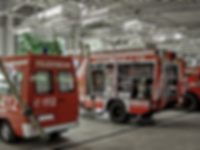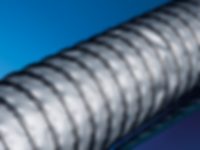Exhaust gas extraction with hoses from Masterduct
Exhaust hoses
The unbeatable Masterduct spiral hoses conduct gaseous media completely safely in a temperature range up to about 1.100 °C. As a responsible person, you know that even below this maximum hot gas temperature, things can get very hot during exhaust gas extration. For example, when engines are being serviced or tested. By processing heat-resistant fabric types, our clip hoses are ideally suited for use in the high-temperature range.
Learn more about the right exhaust hoses.
MaterialsConstruction & Manufacturing
Our safety and quality requirements and experienced staff allow you to find exactly what you're looking for.



For the production of exhaust hoses, we mainly use fabric strips and a so-called clamping profile ("clip"). The clamping profile is supplied as a steel strip and is converted into a profile by us using special forming tools. The fabric strips are inserted into this clamping profile while the clipping machine moves the profile in a helical motion and simultaneously presses the clamping profile shut. With this special clamping process (or "clipping process"), the hose profile is connected to the outer metal spiral mechanically and at the same time with extreme tensile strength. Depending on the load, the hoses can also be manufactured in multiple layers. With their outer spiral, clamping profile hoses also have a "built-in" protective profile.
Dynamic stress due to vibration
Clip hoses are most often used where mobile operating equipment is connected or at least one connection side is mobile. Our clip hose design undoubtedly guarantees a very high mechanical load capacity, because in the classic areas of application for our clip hoses, it is mostly vibration and oscillation movements (e.g. during the operation of motors) that require appropriate mechanical strength.
Vacuum operation / vacuum proof
To ensure that our double-walled clip hoses retain their shape during vacuum operation and under increased dynamic stress, we equip individual hose types with special design features. For example, woven-in reinforcing components in the Master-Clip HT 400, Master-Clip HT 450 and Master-Clip HT 650 provide increased vacuum resistance. With our exhaust hoses, you are definitely well equipped.
For the production of clip hoses for suction or exhaust hoses, we use reliable types of woven fabrics and glass fabrics that differ from each other in their properties. Depending on the substances, gases or liquids to be transported, the required temperature ranges or the mechanical loads to be expected, we have a wide range of high-quality technical fabrics at our disposal. These can be knitted fabrics made of glass, polyamide, polyester and aramid fibers such as Nomex® or Kevlar® as well as ceramic material. Special rubbers such as Neoprene®, CSM and special elastomers such as Viton®, Nitril® or butyl are used for the coating. Many types of fabric are especially heat resistant, provide high fire resistance and thus enable use in high-temperature applications.

We produce silicone-free!
The material silicone is characterized by high water and heat resistance. However, silicone-containing substances can severely impair paint compatibility. In automotive engineering, for example, even the slightest contamination can lead to severe surface disturbances during painting, which is why silicone-free production of hoses is often essential.
The property "silicone-free", can be found in the following tabs:
- Exhaust hoses
- Temperature-resistant hoses up to +1,100 °C
Standards Exhaust hose
Testing of the fire behavior of materials and components is carried out in Germany according to DIN 4102-1 and in Europe according to EN 13501-1. Different fire resistance classes or fire protection classes are distinguished according to their fire behavior. As a result of a design test, hoses can also receive a corresponding approval as soon as they are classified as flame-retardant and/or fall below certain fire velocities.
In this product group, the Master-Clip HT 450 has been tested according to DIN EN 13501-1 and classified as flame-retardant. For more information on operation and safety as well as usage information on our exhaust hoses, please contact our expert sales department.

















